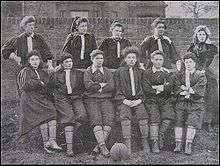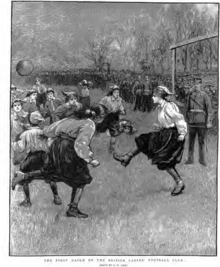British Ladies' Football Club
The British Ladies' Football Club was an all-woman football team formed in Great Britain in 1885. The team had as its patron Lady Florence Dixie, an aristocrat from Dumfries, and its first captain was Nettie Honeyball (real name likely Mary Hutson).[1]

The club's first public match took place at Crouch End, London on 23 March 1895, between teams representing 'The North' and 'The South'. The North won 7–1 in front of an estimated 11,000 spectators.[2]
Historical perspective

Until the 19th century, women's participation in football was limited to folk rituals linked with marriage customs. In Inverness, for example, single women would annually play a match with married women, whilst prospective husbands watched from the sidelines.[3] The first record of a woman's team coming together to play football occurred on 9 May 1881, at Edinburgh's Easter Road Stadium. The match was billed as a Scotland v England international and featured Mrs Graham's XI.[4][5]
Just over a week later, on 20 May 1881,[5] the teams played in Glasgow in front of a crowd of 5,000. This match had to be abandoned following a violent pitch invasion during which the women were "roughly jostled", and chased by a mob as they left the grounds.[4] Further games resulted in similar pitch invasions, which soon resulting in ending this early attempt to introduce women's football.[6]
It is uncertain, from the coverage of the time, what the pitch invasions were in protest against. However, the press tone, which would dominate coverage of women's football for the next century, was clearly established in 1881: barely disguised contempt regarding player appearance, including costume, and the standard of play,[4] overlaid with a certainty that football was a rough man's game unsuitable for women.[6]
Foundation
An attempt to form a new club was made by Alfred Hewitt Smith[7] with Nettie Honeyball as the figurehead for the British Ladies Football Club founded on 1 January 1895.[6] Lady Florence Dixie, the youngest daughter of the Marquess of Queensbury,[8] acted as chairman and sponsor. In 1894, an advertisement was placed in the Daily Graphic seeking those interested in forming a football club for women[9] which attracted around 30 women, who trained twice weekly under the tutelage of Tottenham Hotspur wing-half Bill Julian.[10]
Reception
The club divided into a north and south team and on 23 March 1895, 10,000[notes 1] spectators watched the inaugural game at Crouch End, London. Unlike in the matches of 1881, players no longer had to wear corsets[11]:xvi and high-heeled boots, but acquired standard man's boots in suitable sizes. They still had to wear bonnets, with the game being stopped if any woman headed the ball and it dislodged either bonnet or hairpin which had to be replaced before the game could resume.[6]
The reaction was generally one of being heckled by the crowd, and press censure,[12] bordering on derision.[10]
Despite this, the club went on tour, sponsored by Lady Dixie,[8] and in the following two years played some 100 exhibition matches.[10] The tour attracted great publicity from the press, though not entirely restricted to the sport as, at the time, women playing football was intricately linked to the 'Rights question'.[8]
The strain of playing so often took its toll, and by September 1896 the ladies could only field a few players. They were also broke, and arriving in Exeter found they had insufficient funds to either leave or pay their hotel bill. Appeals to the mayor of Exeter fell on deaf ears and he refused to pay. The ladies had to be rescued by friends, and the activities of the club came to an end.[6]
Women's football once again fell into obscurity until the First World War, when Lloyd George required women to work in factories whilst the men were at the front. On Christmas Day, 1916, the first recorded match between factory organised women's teams, occurred in Ulverston, Cumbria.[6]
Political agenda
In a year when the cultural, social and public concern over what was decent and what was unnatural were already focused,[notes 2] football for women raised important issues within Victorian society, including dress reform, the feminine ideal, women's sexuality, and the rigid British class structure in a way that no other sport could.[11]:xvi
Lady Dixie, a keen advocate of women's rights,[14] believed that football was excellent for women's physiques, and predicted a day when it would be as popular with girls as with boys.[6] Moreover, she was a supporter of the rational dress movement, which sought to liberate women from the corsets and petticoats of Victorian society. She, therefore, saw football as a weapon of subversion and a means of pushing the boundaries, since the members of the club played openly in knickers and blouses.[15]:201
Nettie Honeyball was well aware of the political ramifications, telling an interviewer that:
- There is nothing of the farcical nature about the British Ladies' Football Club. I founded the association late last year, with the fixed resolve of proving to the world that women are not the 'ornamental and useless' creatures men have pictured. I must confess my convictions on all matters, where the sexes are so widely divided, are all on the side of emancipation, and I look forward to the time when ladies may sit in Parliament and have a voice in the direction of affairs, especially those which concern them most.[11]:25
notes
- Variously reported in newspapers at the time as up to 11,000[2]
- Oscar Wilde's trial began in April and concluded in May with his conviction for indecency against Lady Dixie's nephew Lord Alfred Douglas[13]:112
References
- "The Honeyballers: Women who fought to play football". BBC News. 26 September 2013. Retrieved 17 February 2015.
- "Ladies' Football Match". The Standard. London. 25 March 1895. Retrieved 17 February 2015 – via British Newspaper Archive.
- Seddon, P. (2004) Football Talk: The Language & Folklore of the World's Greatest Game page 156 Robson. ISBN 1861056834 Retrieved February 2015
- Domeneghetti, R. (2014) From the Back Page to the Front Room: Football's journey through the Englismedia page 155 Ockley Books. ISBN 1783015586 Retrieved February 2015
- Tate, T. (2013) Girls with Balls - The Secret History of Women's Football John Blake Publishing. ISBN 1782196862 Retrieved February 2015
- Laycock, S. & Laycock, P. (2014) Unexpected Britain page 199 Amberley Publishing. ISBN 1445632845 Retrieved February 2015
- Tomlinson, A. (2010) A Dictionary of Sports Studies page 490 Oxford University Press. ISBN 019921381X Retrieved February 2015
- Williams. J. (2013) A Game for Rough Girls?: A History of Women's Football in Britain page 26 Routledge. ISBN 1135136149 Retrieved February 2015
- Rippon, A. (2012) Amazing & Extraordinary Facts - Football page 38 Archived 26 February 2015 at the Wayback Machine David & Charles. ISBN 1446357449 Retrieved February 2015
- Brown, P. (2013) The Victorian Football Miscellany page 156 Superelastic. ISBN 0956227058 Retrieved February 2015
- Lee, J. (2013) The Lady Footballers: Struggling to Play in Victorian Britain Routledge. ISBN 041542609X Retrieved May 2017
- Mangan, J.A. & Nauright, J. (2013) Sport in Australasian Society: Past and Present page 134 Routledge ISBN 1136332243 Retrieved February 2015
- Williams, J. (2007) A Beautiful Game: International Perspectives on Women's Football page 112 Berg. ISBN 1847883451 Retrieved February 2015
- Hong, F. & Mangan, J.A. (2004) Soccer, Women, Sexual Liberation: Kicking Off a New Era page 283 Taylor & Francis ISBN 0714684082 Retrieved February 2015
- Sanders, R. (2010) Beastly Fury: The Strange Birth Of British Football page 201 Random House. ISBN 1446421309 Retrieved February 2015
Further reading
- Grainey, Timothy (2012), Beyond Bend It Like Beckham: The Global Phenomenon of Women's Soccer, University of Nebraska Press, ISBN 0803240368
- Lee, James (2008). The Lady Footballers: Struggling to Play in Victorian Britain, Routledge, ISBN 041542609X
- Lopez, Sue (1997). Women on the ball: a guide to women's football, Scarlet Press, ISBN 1857270169
- Tate, Tim (2013). Girls With Balls: The Secret History of Women's Football, John Blake, ISBN 1782196862
- Williams, Jean (2007). A Beautiful Game: International Perspectives on Women's Football, Apex Publishing LLC, ISBN 1847883451